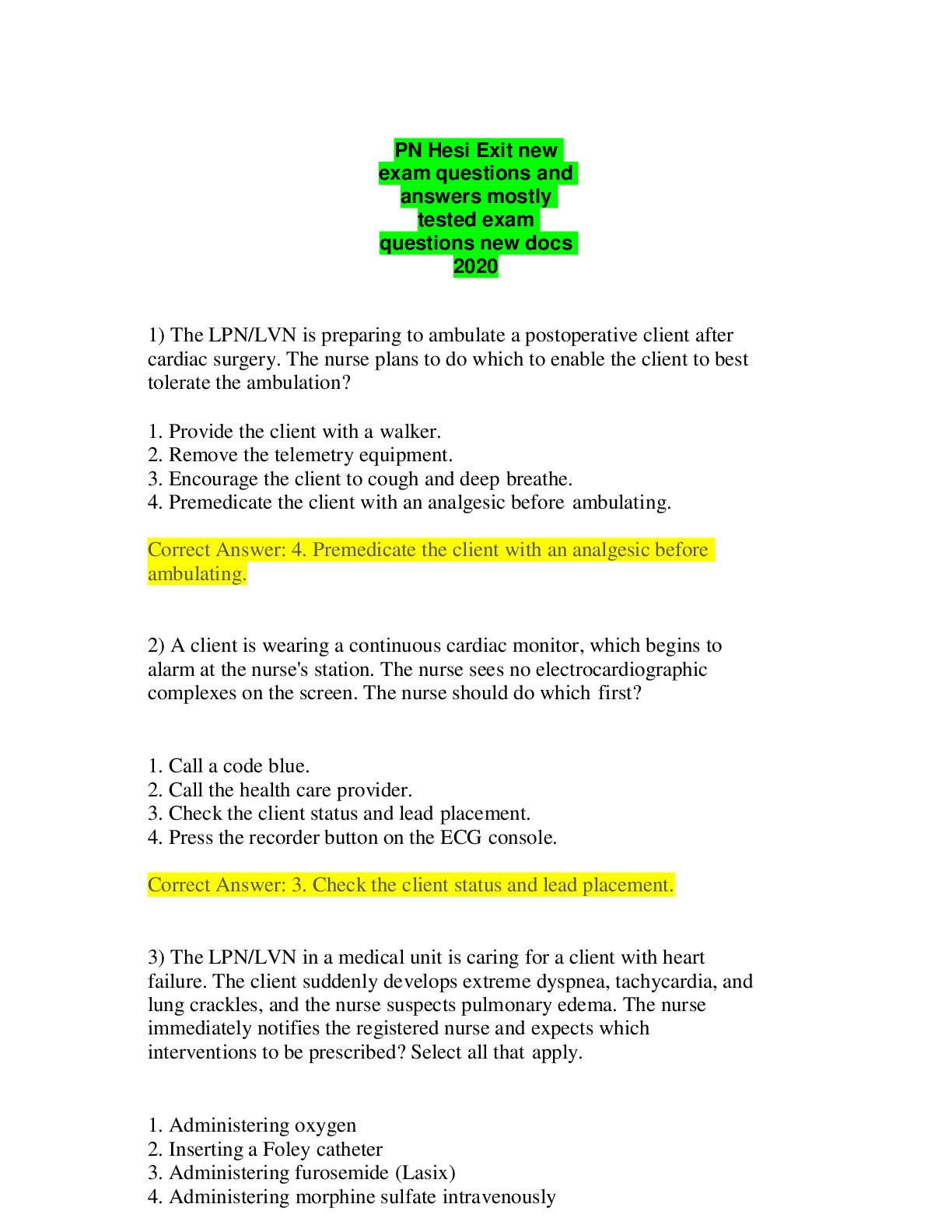*NURSING > HESI > OB HESI/FINAL Exam Questions and answers, Latest update, 100% proven pass rate. (All)
OB HESI/FINAL Exam Questions and answers, Latest update, 100% proven pass rate.
Document Content and Description Below
OB HESI/FINAL Exam Questions and answers, Latest update, 100% proven pass rate. A client who delivered an infant an hour ago tells the nurse the she feels wet underneath her buttock. The nurse no... tes that the perineal pad is saturated and the client is lying in a 6-inch diameter pool of blood. Which action should the nurse implement first? A. Cleanse the perineum B. Obtain a blood pressure C. Palpate the firmness of the fundus D. Inspect the perineum for lacerations - ✔✔Correct Answer: C A firm uterus is needed to control bleeding from the placental site of attachment on the uterine wall. The nurse should FIRST assess for firmness and massage the fundus as indicated. A woman who thinks she could be pregnant calls her neighbor, who is a nurse, to ask when she should use a home pregnancy test. Which response is appropriate? A. "A home pregnancy test can be used right after your first missed period." B. "These tests are most accurate after you missed your second period." C "Home pregnancy tests often give false positives and should not be trusted." D. "The test can provide accurate information when used right after ovulation." - ✔✔Correct Answer: A Home urine test are based on the chemical detection of human chorionic gonadotrophin, which begins to increase 6-8 days after conception. Best detected at 2 weeks gestation or immediately after first missed period. When explaining "postpartum blues" to a client who is 1 day postpartum, which symptoms should the nurse include in the teaching plan? (Select all that apply) A. Mood swings B. Panic attacks C. Tearfulness D. Decreased need for sleep E. Disinterest in the infant - ✔✔Correct Answers: A,C "Postpartum blues" is a common emotional response related to the rapid decrease in placental hormones after delivery and include mood swings, teaefulness, feeling low, emotional, and fatigued. B,D, and E indicate "Postpartum Depression" One hour after giving birth to an 8-pound infant, a client's lochia rubra has increased from small to large and her fundus is boggy despite massage. HR is 84 bpm, BP 156/96. The M.D. prescribe Methergine 0.2 mg IM x 1. Which action should the nurse take immediately? A. Give the medication as prescribed and monitor for efficacy B. Encourage the client to breastfeed rather than bottle feed C. Have the client empty her bladder and massage her fundus D. Call the HP to question the prescription - ✔✔Correct Answer: D Methergine is contraindicated for clients with elevated BP, so the nurse should contact the HP and question the prescription. The nurse should encourage the laboring patient to begin pushing when A. there is only an anterior or posterior lip of cervix left B. the client describes the need to have a BM C. the cervix is completely dilated C. the cervix is completely effaced - ✔✔Correct Answer: C Pushing begins with the second stage of labor (i.e. when the cervix is completely dilated at 10 cm). Pushing before this point could case the cervix to become edematous = operative delivery. A client at 32-weeks gestation is hospitalized with severe pregnancy-induced hypertension (PIH), and magnesium sulfate is prescribed to control the symptoms. Which assessment finding indicates the therapeutic drug level has been achieved? A. 4+ reflexes B. Urinary output of 50 ml/hr C. A decrease in RR from 24 to 16 D. A decreased body temp - ✔✔Correct Answer: C Magnesium sulfate, a CNS depressant, helps prevent seizures.** RR <12 indicate toxicity, Urine output should be at least 30 ml/hr Twenty-four hours after admission to the newborn nursery, a full-term male infant develops localized edema on the right side of his head. The nurse knows that, in the newborn, an accumulation of blood between the periosteum and skull which does not cross the suture line is a newborn variation known as A. a cephalhematoma, caused by forceps trauma and may last up to 8 weeks B. a subarachnoid hematoma, which requires immediate drainage to prevent complications C. molding, caused by pressure during labor and will disappear within 2 to 3 days D. a subdural hematoma which can result in lifelong damage - ✔✔Correct Answer: A A slight abnormal variation of the newborn, usually arises within first 24 hours after delivery. Trauma from delivery causes capillary bleeding between the periosteum and the skull (B) a cranial distortion lasting 5-7 days, caused by pressure on the cranium (C&D) involves cranial bleeding; cannot be detected on physical exam alone A couple has been trying to conceive for nine months without success. Which information obtained from the clients is most likely to have an impact on the couple's ability to conceive a child? A. Exercise regimen of both partners includes running four miles each morning B. History of having sexual intercourse 2-3 times per week C. The woman's menstrual period occurs every 35 days D. They use lubricants with each sexual encounter to decrease friction - ✔✔Correct Answer: D The use of lubricants has the potential to affect fertility because some lubricants interfere with sperm motility Which action should the nurse implement when preparing to measure the fundal height of a pregnant client? A. Have the client empty the bladder B. Request the client lie on her left side C. Perform Leopold's maneuvers first D. Give the client some juice - ✔✔Correct Answer: A The bladder must be completely empty to accurately measure the fundal height. An off-duty nurse finds a woman in a supermarket parking lot delivering an infant while her husband is screaming for someone to help his wife. Which intervention has the highest priority? A. Use a thread to tie off the umbilical cord B. Provide as much privacy as possible C. Reassure the husband and try to keep him calm D. Put the newborn to breast - ✔✔Correct Answer: D Putting the newborn to breast will help contract the uterus and prevent a postpartum hemorrhage. Preventing hemorrhage is the highest priority. A client at 28-weeks gestation calls the antepartal clinic and states that she is experiencing a small amount of vaginal bleeding which she describes as bright red. She further states that she is not experiencing any uterine contractions or abdominal pain. Which instruction should the nurse provide? A. Come to the clinic today for an ultrasound B. Go immediately to the emergency room C. Lie on your left side for about one hour and see if the bleeding stops D. Bring a urine sample to the lab tomorrow to determine if you have a UTI - ✔✔Correct Answer: A Third trimester painless bleeding is characteristic of a placental previa. Bright red bleeding may be intermittent, occur in gushes, or be continuous **Bleeding that is sudden and accompanied by intense uterine pain indicates placental abruption, which IS life threatening An expectant father tells the nurse he fears that his wife "is losing her mind." He states she is constantly rubbing her abdomen and talking to the baby, and that she actually reprimands the baby when it moves too much. What recommendation should the nurse make to this expectant father? A. Reassure him that these are normal reactions to pregnancy and suggest that he discuss his concerns with the childbirth education nurse B. Help him to understand that his wife is experiencing normal symptoms of ambivalence about the pregnancy and no action is needed C. Ask him to observe his wife's behavior carefully for the next few weeks and report any similar behavior to the nurse D. Let him know that these are normal maternal/fetal bonding behaviors which occur once the mother feels fetal movement - ✔✔Correct Answer: D These behaviors are positive maternal/fetal bonding The nurse assesses a client admitted to the labor and delivery unit and obtains the following data: dark red vaginal bleeding, uterus slightly tense between contractions, BP 110/68, FHR 110 beats/minute, cervix 1 cm dilated and uneffaced. Based on these assessment findings, what intervention should the nurse implement? A. Insert an internal fetal monitor B. Assess for cervical changes q1h C. Monitor bleeding from IV sites D. Perform Leopold's maneuvers - ✔✔Correct Answer: D The client is presenting with signs of placental abruption so monitoring bleeding from peripheral IV sites is priority. WHY? Disseminated intravascular coagulation (DIC) is a complication of PA characterized by abnormal bleeding A client in active labor is admitted with preeclampsia. Which assessment finding is most significant in planning this client's care? A. Ask if she takes a daily calcium tablet B. Extend the leg and dorsiflex the foot C. Lower the leg off the side of the bed D. Elevate the leg above the heart - ✔✔Correct Answer: B Dorsiflexinfg the foot by pushing the sole of the foot forward or by standing is the best means of relieving leg cramps Which maternal behavior is the nurse most likely to see when a new mother receives her infant for the first time? A. She eagerly reaches for the infant, undresses the infant, and examines the infant completely B. Her arms and hands receive the infant and she then traces the infant's profile with her fingertips C. Her arms and hands receive the infant and she then cuddles the infant to her own body D. She eagerly reaches for the infant and then holds the infant to her own body - ✔✔Correct Answer: B Attachment/bonding theory indicates that most mothers will demonstrate behaviors described in (B) The nurse should explain to a 30-year-old gravid client that alpha fetoprotein testing is recommended for which purpose? A. Detect cardiovascular disorders B. Screen for neural tube defects C. Monitor the placental functioning D. Assess for maternal pre-ecplamsia - ✔✔Correct Answer: B Alpha-fetoprotein (AFP) is a screening test used in pregnancy. Elevation may indicate neural tube defect A new mother is afraid to touch her baby's head for fear of hurting the "large soft spot." Which explanation should the nurse give to this anxious client? A. "Some care is required when touching the large soft spot area on top of your baby's head until the bones fuse together" B. "That's just an 'old wives' tale' so don't worry" C. "The soft spot will disappear within 6 weeks and if very unlikely to cause any problems for your baby" D. "There's a strong, tough membrane there to protect the baby so you need not be afraid to wash or comb their hair" - ✔✔Correct Answer: D Provides correct information and relieves any anxiety The nurse is counseling a woman who wants to become pregnant. The woman tells the nurse that she has a 36-day menstrual cycle and the first day of her last menstrual period was January 8. The nurse correctly calculates that the woman's next fertile period is A. January 14-15 B. January 22-23 C. January 30-31 D. February 6-7 - ✔✔Correct Answer: C Ovulation occurs 14 days before the first day of the menstrual period. The nurse caring for a laboring client encourages her to void at least q2h, and records each time the client empties her bladder. What is the primary reason for implementing this nursing intervention? A. Emptying the bladder during delivery is difficult because of the position of the presenting fetal part B. An over-distended bladder could be traumatized during labor, as well as prolong the progress of labor C. Urine specimens for glucose and protein must be obtained at certain intervals throughout labor D. Frequent voiding minimizes the need for catheterization which increases the chance of bladder infection - ✔✔Correct Answer: B A full bladder can impair the efficacy of the uterine contractions and impede descent of the fetus during labor A woman with Type 2 diabetes mellitus becomes pregnant, and her oral hypoglycemic agents are discontinued. Which intervention is most important for the nurse to implement? A. Describe diet changes that can improve the management of her diabetes B. Inform the client that oral hypoglycemic agents are teratogenic during pregnancy C. Demonstrate how to administer insulin D. Evaluate the client's ability to do glucose monitoring - ✔✔Correct Answer: A Diet modifications are effective in managing this type of diabetes during pregnancy. The other answers should be implemented but are not a PRIORITY A new mother who has just had her first baby says to the nurse, "I saw the baby in the recovery room. She sure has a funny looking head." Which response by the nurse is best? A. This is not an unusual shaped head. espec - ✔✔ The nurse observes a 4-year-old boy in a day care setting. Which behavior should the nurse consider normal for this child? A. Has a temper tantrum when told he must share toys B. Plays by himself most of the day C. Demonstrates aggressiveness by boasting when telling a story D. Begins to cry and is tearful when separated from parents - ✔✔Correct Answer: C 4 year old children are aggressive in their play and enjoy "tale-telling". A six month old returns from surgery with elbow restraints. What nursing care should be included when caring for a child in restraints? A. Keep restraints on at all times B. Remove restraints one at a time and provide ROM exercises C. Remove all restraints simultaneously and provide play activities D. Renew the HP's order for restraints every 72 hours - ✔✔Correct Answer: B Removing restraints one at a time is safer than removing them all at once. A 14-year-old female client tells the nurse that she is concerned about the acne she has recently developed. Which recommendation should the nurse provide? A. Remove all blackheads and follow with an alcohol scrub B. Use medical cosmetics only to help hide the blemishes C. Wash the hair and skin frequently with soap and hot water D. Encourage her to see a dermatologist as soon as possible - ✔✔Correct Answer: C Washing the hair and skin frequently removes oils and debris from the skin, which help prevent and treat acne. What preoperative nursing intervention should be included in the plan of care for an infant w/ pyloric stenosis? A. Monitor for signs of metabolic acidosis B. Estimate the quantity of diarrhea stools C. Place in supine position after feeding D. Observe for projectile vomiting - ✔✔Correct Answer: D A classic sign of pyloric stenosis, which contributes to metabolic alkalosis A 2-year-old child with Downs Syndrome is brought to the clinic for his regular physical exam. The nurse knows which problem is frequently associated with DS A. Congenital heart disease B. Fragile X chromosome C. Trisomy 13 D. Pyloric Stenosis - ✔✔Correct Answer: A The most common associated condition associated with DS. (B&C) involve abnormalities with chromosomes but are not associated with DS Which action by the nurse is most helpful in communicating with a preschool-aged child? A. Speak clearly and directly to the child B. Use a doll to play and communicate C. Approach when parent is not present D. Play a board game with the child - ✔✔Correct Answer: B Playing with the child using a doll or another toy helps them feel more comfortable with a stranger. The vital signs of 4 yr old child w/ polyuria are: BP 80/40, pulse, 118, and Resp. 24. The child's pedal pulses are present w/ a volume of +1, and no edema is observed. What action should the nurse implement first? A. Insert an indwelling catheter B. Start an IV infusion of normal saline C. Send a specimen to the lab for urinalysis D. Document the child's vital signs and pulses - ✔✔Correct Answer: B The child is experiencing fluid volume deficit as evidenced by the VS and decreased pulse pressures. **Priority is to restore fluids During discharge teaching of a child with juvenile rheumatoid arthritis, the nurse should stress to the parents the importance of obtaining which diagnostic testing? A. Hearing tests B. Eye exams C. Chest X-rays D. Fasting blood glucose test - ✔✔Correct Answer: B Visuals changes resulting in blindness can occur in children with JRA. A child falls on the playground and is brought to the school nurse with a small laceration on the forearm. Which action should the nurse implement first? A. Slowly pour hydrogen peroxide over the open wound B. Apply ice to the area before rinsing with cold water C. Wash the wound gently with mild soap and water D. Gently cleanse with a sterile pad using povidone-iodine - ✔✔Correct Answer: C A small superficial laceration should be cleansed thoroughly. (A&D) can be traumatic/painful when cleaning fresh, open wounds Which finding in a 19 yr old female client should trigger further assessment by the nurse? A. Menstruation has not occurred B. Reports no tetanus immunization since childhood C. Denies having any wisdom teeth D. History of painful, inwards growth on bottom of foot - ✔✔Correct Answer: A Menstruation is a secondary sex-characteristic that should occur before age 18. (B) A tetanus booster is generally given at age 16. As part of the physical assessment of children, the nurse observes and palpates the fontanels. Which child's fontanel finding should be reported to the healthcare provider? A. A 6-month old with failure to thrive that has a closed anterior fontanel B. A 24-month old with gastroenteritis that has a closed posterior fontanel C. A 2-month old with chickenpox that has an open posterior fontanel D. A 28-month old with hydrocephalus that has an open anterior fontanel - ✔✔Correct Answer: A At 6-months of age the anterior fontanel should be open and it should not be closed until approximately 18-months of age. (B&C) are normal findings. (D) A child with hydrocephalus may have delayed closing What intervention is required for a teenager experiencing acute glomerulonephritis with a BP of 170/88 (previously 210/110)? A. Give the patient their oral diuretic early B. Administer PRN nifedipine (Procardia) sublingually C. Notify the HP and the charge nurse of the patient's condition D. Attempt to calm the patient and retake the BP in 30 min - ✔✔Correct Answer: B Sublingual Procardia administered sublingual lowers BP quickly and should be done first. (A) Oral diuretics do not work as quickly, but may also be done. A 3-month-old develops oral thrush. Which pharmacological agent should the RN administer? A. Nystatin B. Nitrofurantoin C. Norfloxacin D. Neomycin sulfate - ✔✔Correct Answer: A Nystatin is an oral antiifungal. Duh. The nurse is teaching a 12-year-old male adolescent and his family about taking injections of growth hormone for idiopathic hypopituitarism. Which adverse S/S are commonly associated with this therapy? A. Polyuria and polydipsia B. Lethargy and fatigue C. Increased facial hair D. Facial bone structure changes - ✔✔Correct Answer: A These are S/S of diabetes or hyperglycemia. Those receiving growth hormone should have their blood glucose monitored to detect elevations and intolerance. The nurse is assessing a 2-year-old. Which behavior indicates that the child's language development is within normal limits. A. Is able to name four colors B. Can count five blocks C. Is capable of making a three word sentence D. Half of child's speech is understandable - ✔✔Correct Answer: C A toddler aged 1-3 years is capable of making 2-3 word sentences A full-term infant is admitted to the newborn nursery and, after careful assessment, the nurse suspects that the infant may have an esophageal atresia. Which symptoms is this newborn likely to have exhibited? A. Choking, coughing, and cyanosis B. Projectile vomiting and cyanosis C. Apneic spells and grunting D. Scaphoid abdomen and anorexia - ✔✔Correct Answer: A Includes the 3 "C's" of esophageal atresia caused by the overflow of secretions into the trachea. (B) is characteristic of pyloric stenosis. (C) could be due to prematurity or sepsis, and grunting indicates respiratory distress. (D) characteristic of diaphragmatic hernia In developing a teaching plan for a 5-year-old child with diabetes, which component of diabetic management should the nurse plan for the child to manage first. A. Food planning and selection B. Administering insulin injection C. Process of glucose testing D. Drawing up the correct - ✔✔Correct Answer: C Developmentally, a 5-year-old has the cognitive and psychomotor skills to use a glucometer. (A,B &D) require a more cognitive/psychomotor advance Which behavior would the nurse expect a 2-year-old to exhibit? A. Build a house with blocks B. Ride a tricycle C. Display possessiveness of toys D. Look at a picture book for 15 minutes - ✔✔Correct Answer: C 2-year-olds are egocentric and unable to share with others What bowel habits are seen in children with Hirschsprung's disease? A. Foul-smelling and fatty B. Bile-colored and watery C. Semi-solid and yellow D. Ribbon-like and brown - ✔✔Correct Answer: D HD is a mechanical obstruction caused by inadequate motility in a part of the intestines. The condition results as a failure of ganglion cells to migrate craniocaudally along the GI tract during gestation. The lack of peristalsis causes constipation and a small diameter, brown-colored stools. A 3-week-old newborn is brought to a clinic for follow-up after a home birth. The child bottle feeds for 5 minutes only then falls asleep. A loud murmur characteristic of ventricular septal defect (VSD), and finds the newborn acyanotic with a RR of 64 bpm. What instruction should be provided to ensure the newborn gets adequate fluid intake? (Select all that apply). A. Monitor the infant's weight and number of wet diapers per day B. Increase the infant's intake per feeding by 1-2 ounces per week C. Mix the dose of prophylactic antibiotic with formula in whole bottle D. Allow the infant to rest and refeed on demand or every 2 hours E. Use a softer nipple or increase the size of the nipple opening - ✔✔Correct Answer: A, B, D & E Infants with VSD fatigue quickly and ingest inadequate amounts. A one-month old infant should ingest 2-4 ounces of formula per feeding to about 30 ounces per day for a 4-month old. The infant should eat every 2 hours to allow for adequate rest in between meals. A larger nipple/nipple size helps to reduce the effort of sucking A 6-month-old boy and his mother are at the health clinic for a well-baby checkup and routine immunization. The HP recommends an influenza vaccine. What medications should the RN plan to administer? A. The routine immunizations and schedule another apt. for the influenza. B. All the immunizations with the influenza being administered in a different site C. The influenza vaccine and schedule another apt. for all other routine immunizations D. The influenza and polio vaccines, then schedule another apt. for the remaining vaccines - ✔✔Correct Answer: B At 6-months of age, routine vaccinations include TDAP, Hep B, HIB, PVC, IPV, and influenza A 2-year-old with gastroesophageal reflux disease has developed a fear of eating. What instruction should the RN include in the parent's teaching plan? A. Invite other children home to share meals B. Accept that he will eat when he is hungry C. Reward the child with a nap after eating D. Consistently follow a set meal-time routine - ✔✔Correct Answer: D A 2-year-old is comforted by consistency. To assess the effectiveness of an analgesic administered to a 4-yr old, what intervention is best for the nurse to implement? A. Use a happy-face/sad-face pain scale B. Ask the mother if she thinks the analgesic is working C. Assess for changes in vital signs D. Teach the child to point to a numeric pain scale - ✔✔Correct Answer: A A 4-year-old can readily identify with simple pictures to show how he/she is feeling Which menu selection by a child w/ celiac disease indicates to the nurse that the child understands necessary dietary considerations? A. Oven-baked potato chips and cola B. Peanut butter and banana sandwhich C. Oat-meal raisin cookies and milk D. Graham crackers and fruit juice - ✔✔Correct Answer: A Celiac disease causes an intolerance to the protein gluten found in oats, rye, wheat and barley (eating foods with this can cause diarrhea). When assessing a child with asthma, the nurse should expect intercostal retractions during A. Inspiration B. Coughing C. Apneic episodes D. Exhalation - ✔✔Correct Answer: A Result of respiratory effort to inhale through restricted airways. A 16-year old boy is brought to the E.D. with a crushed leg after falling off a horse. His last tetanus toxoid booster was received at 8-years old. Which action should the nurse take? A. Dispense a tetanus antitoxin B. Prepare human tetanus immune globulin C. Administer tetanus toxoid booster D. Delay the tetanus toxoid booster - ✔✔Correct Answer: C [Show More]
Last updated: 1 year ago
Preview 1 out of 53 pages
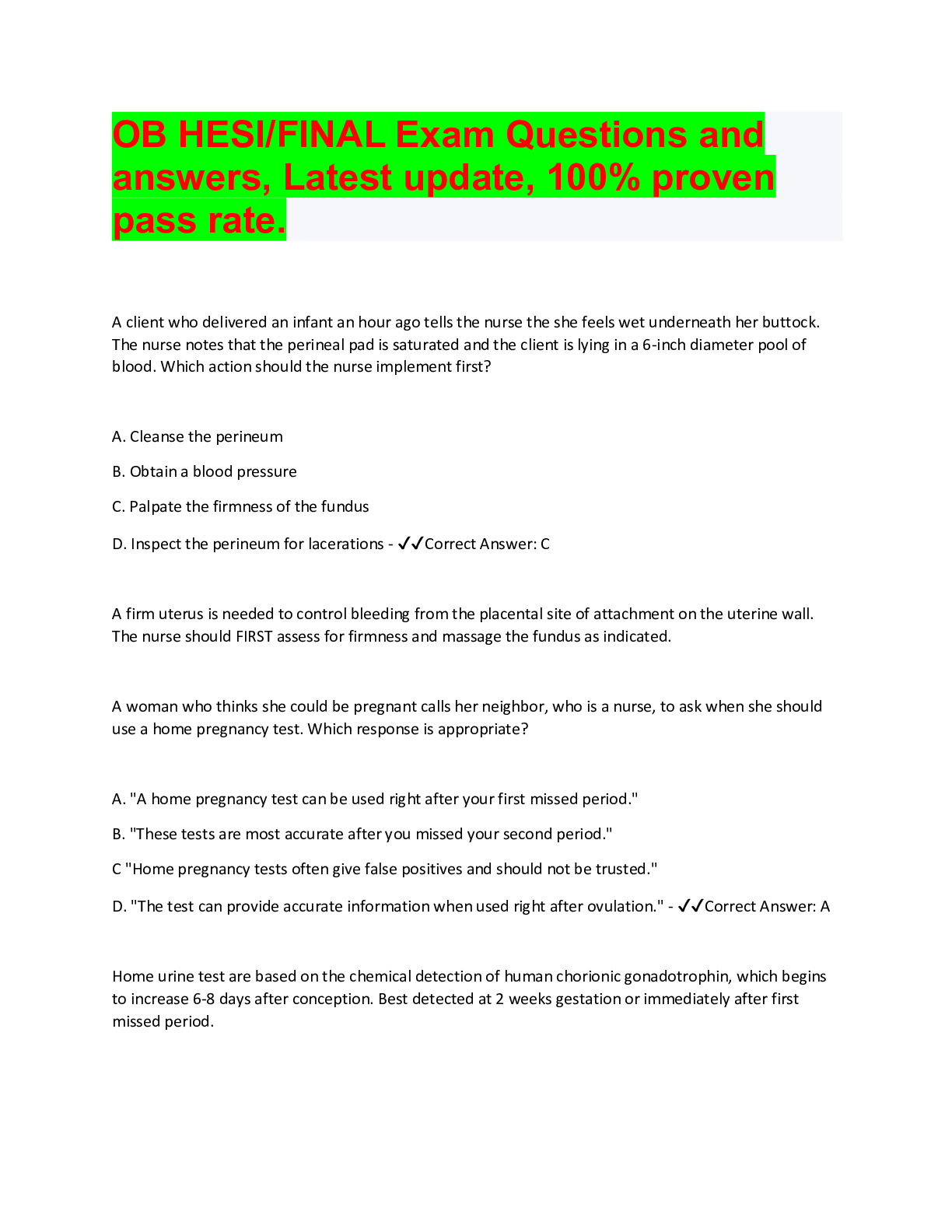
Buy this document to get the full access instantly
Instant Download Access after purchase
Add to cartInstant download
We Accept:

Reviews( 0 )
$10.00
Document information
Connected school, study & course
About the document
Uploaded On
Aug 27, 2022
Number of pages
53
Written in
Additional information
This document has been written for:
Uploaded
Aug 27, 2022
Downloads
0
Views
85

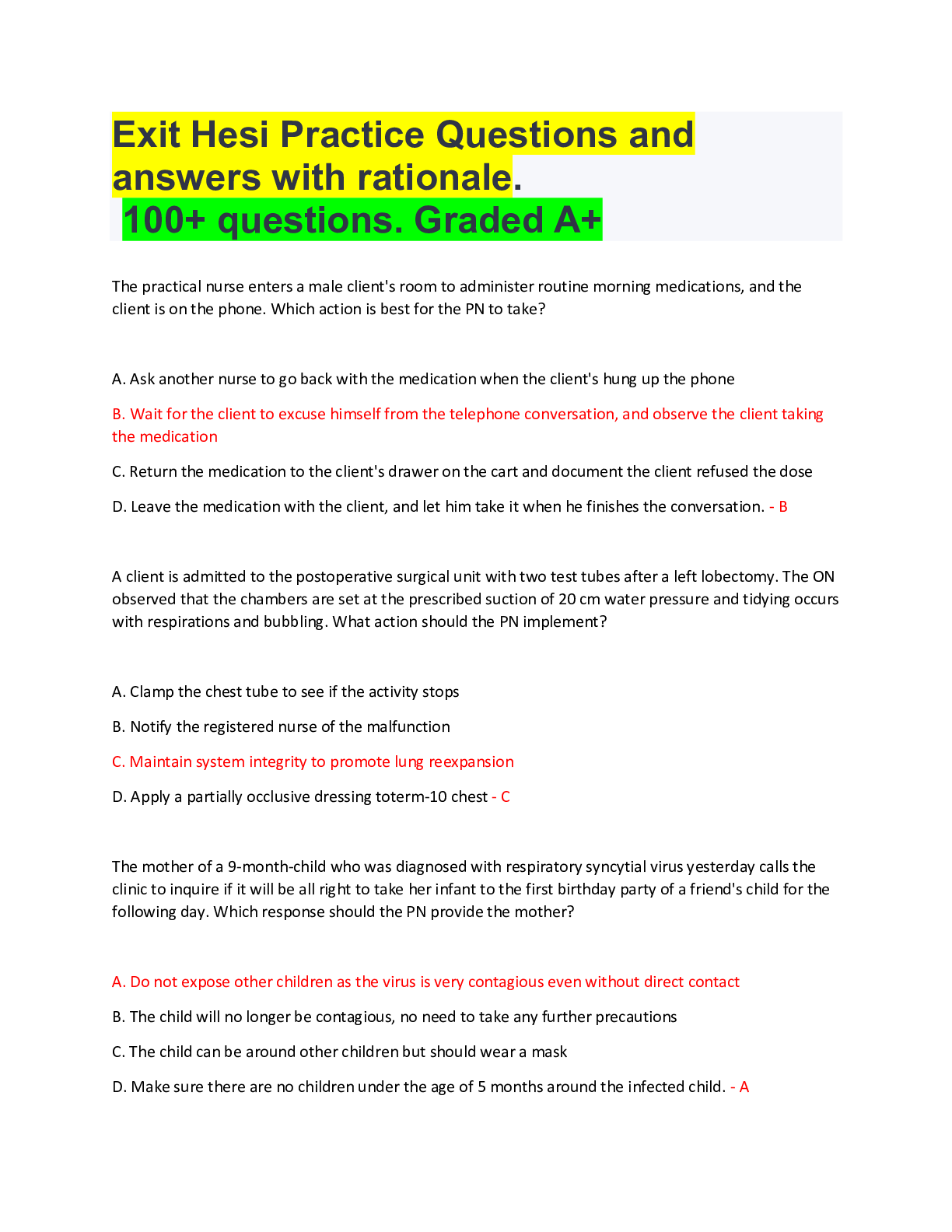

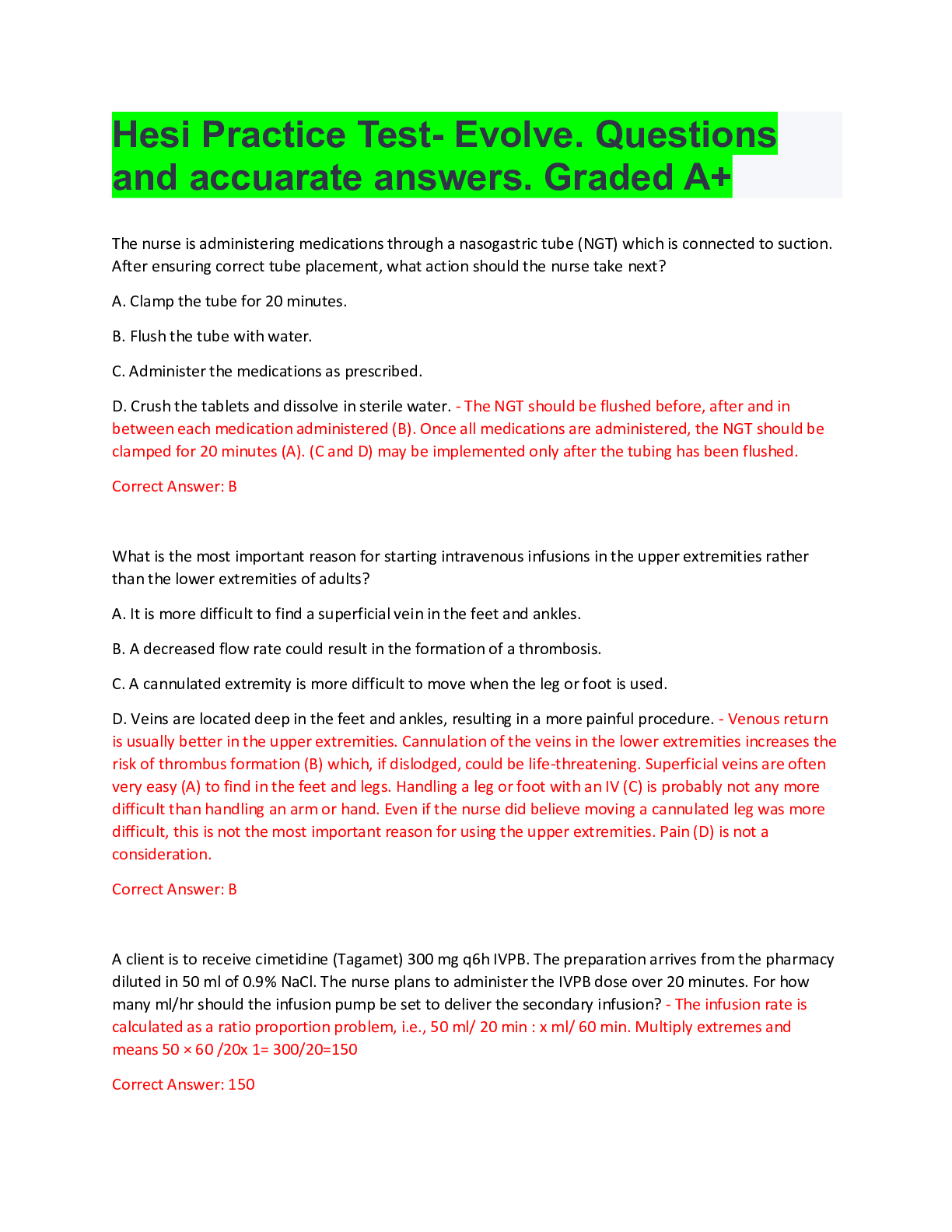
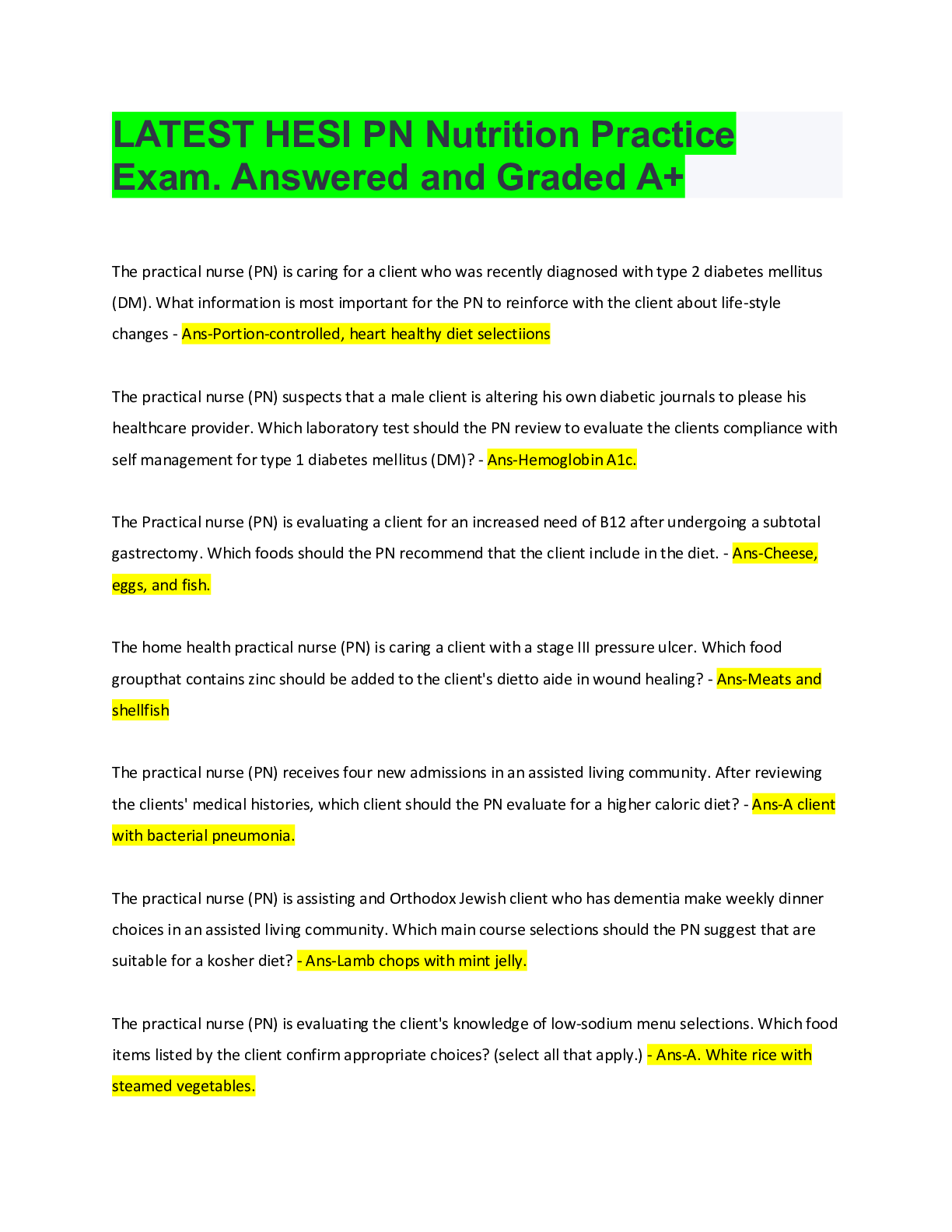


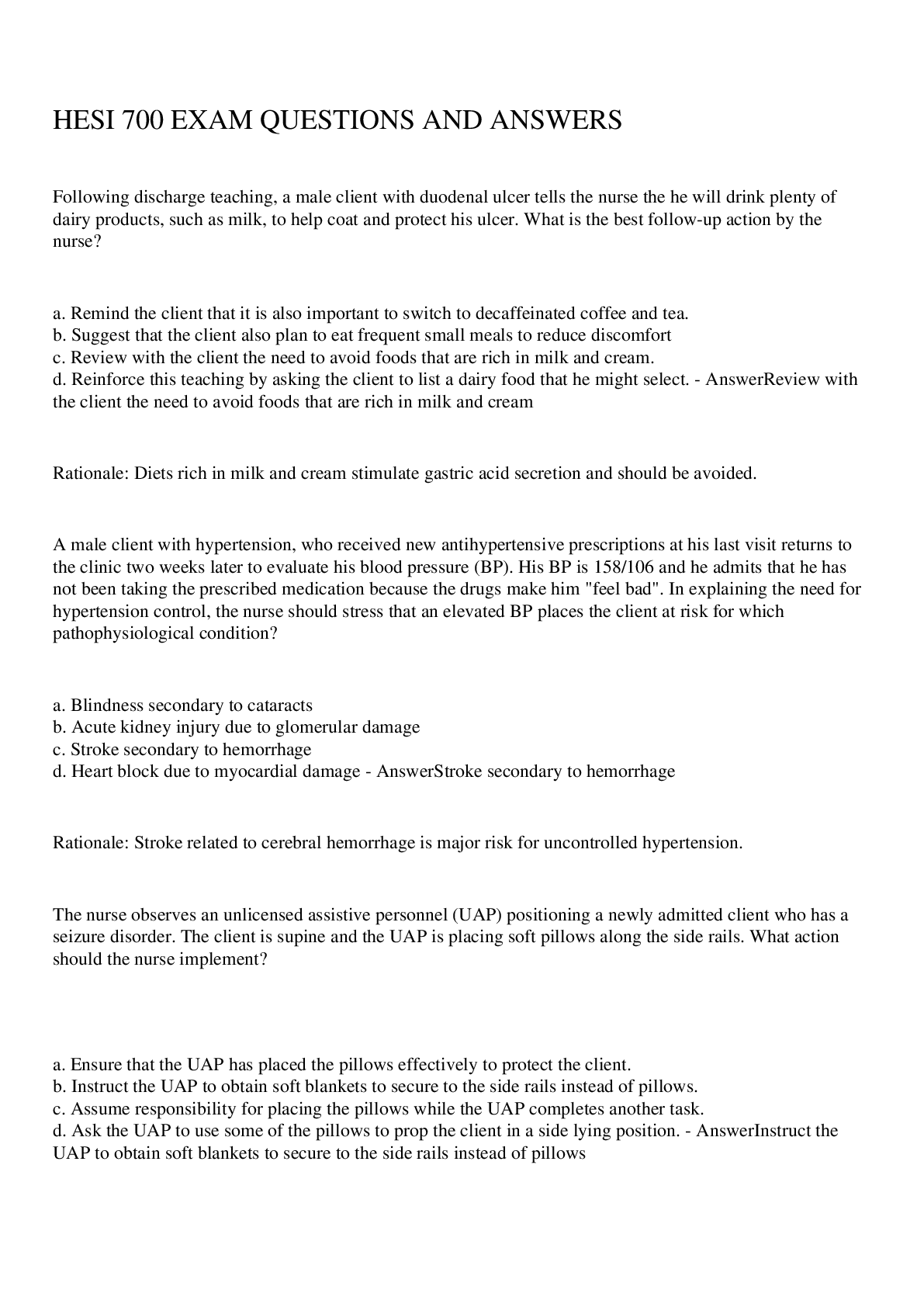


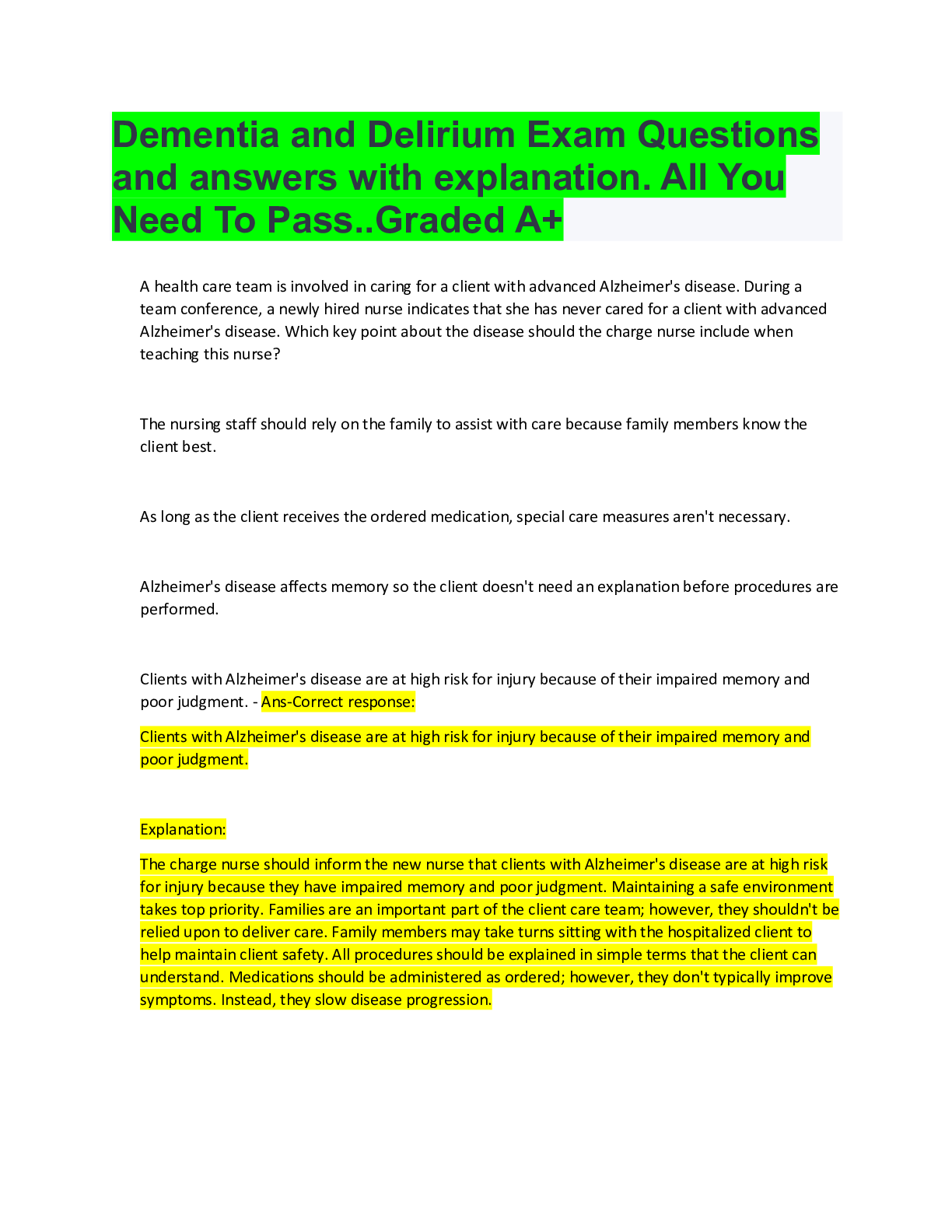

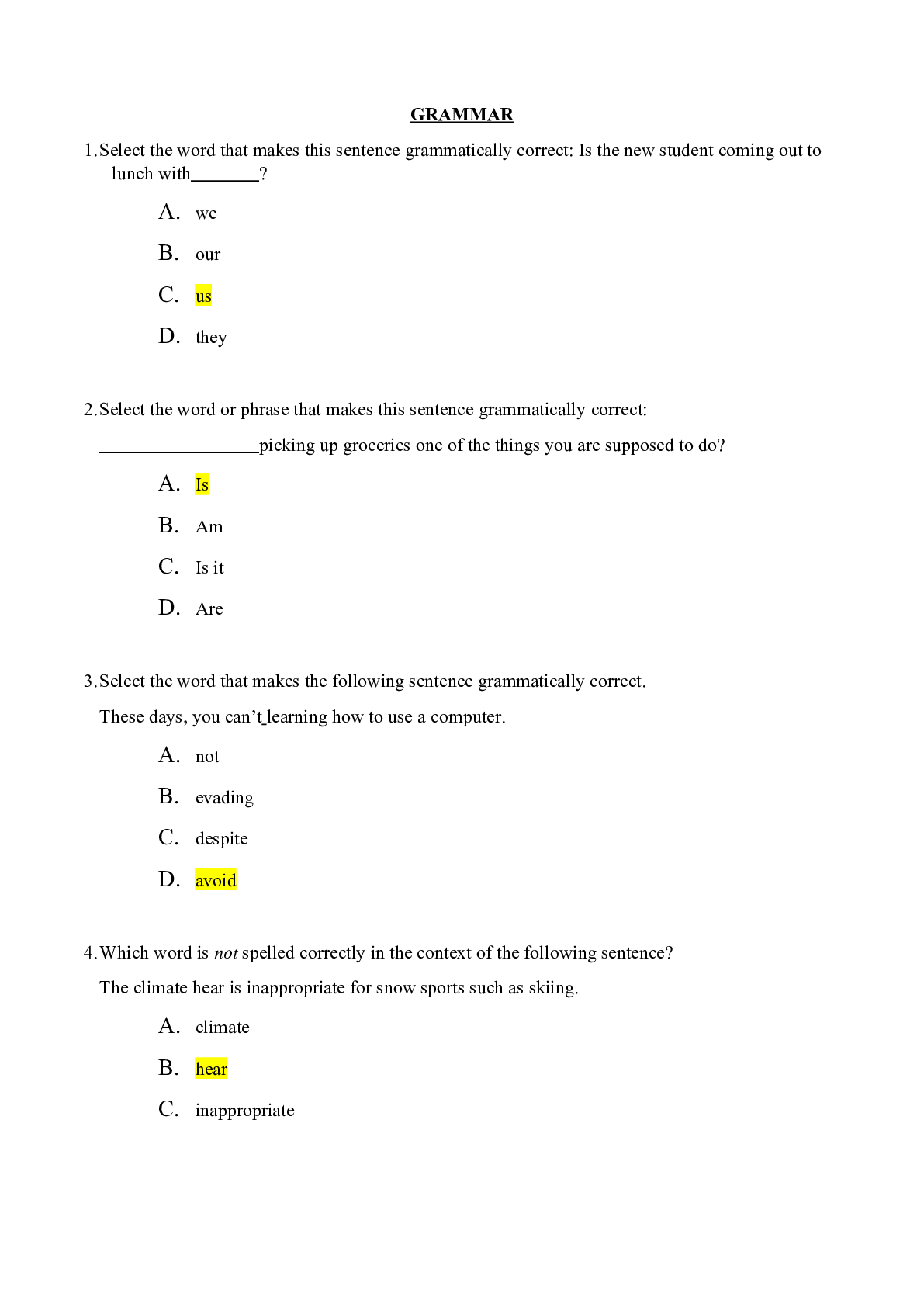
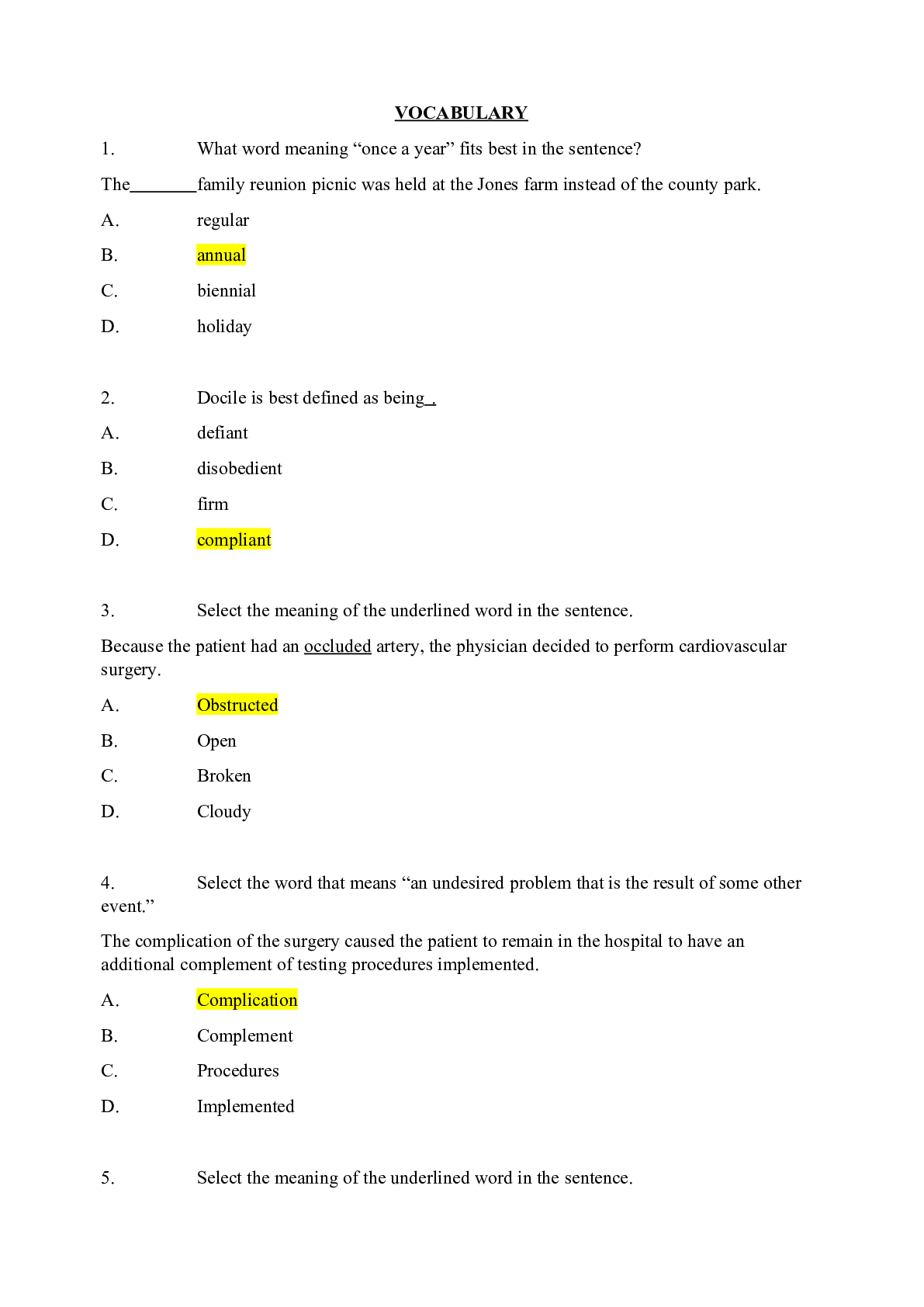
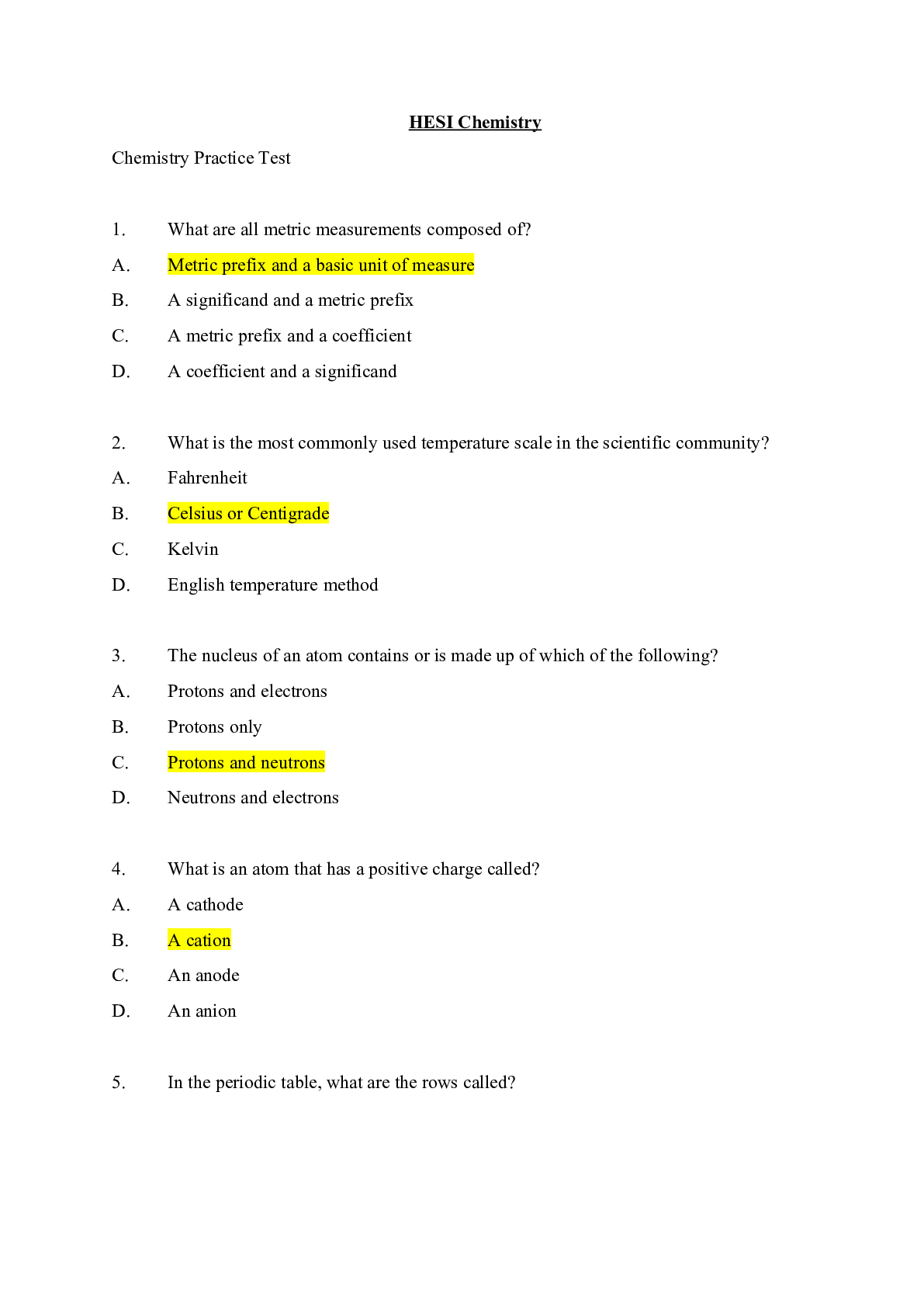

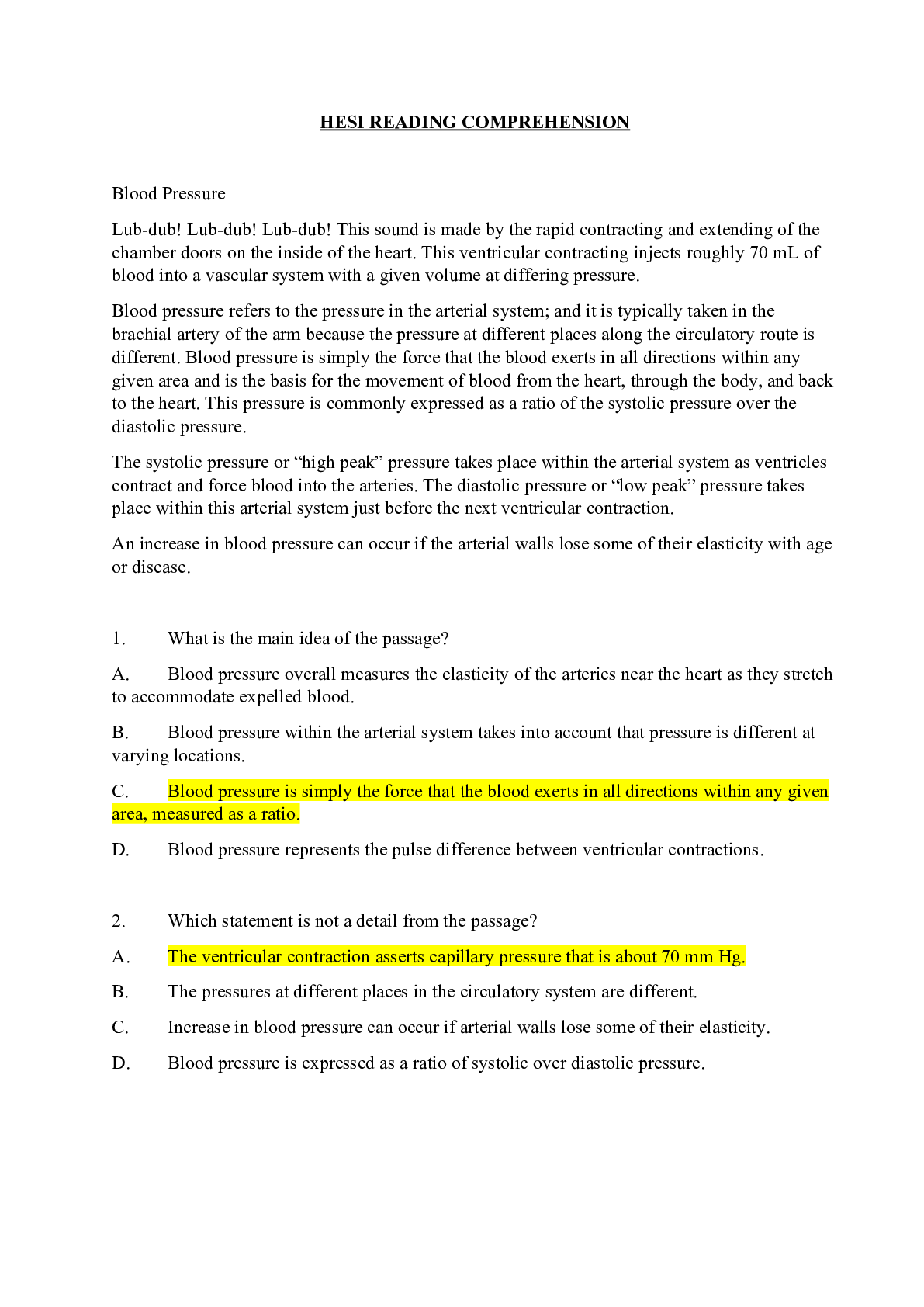

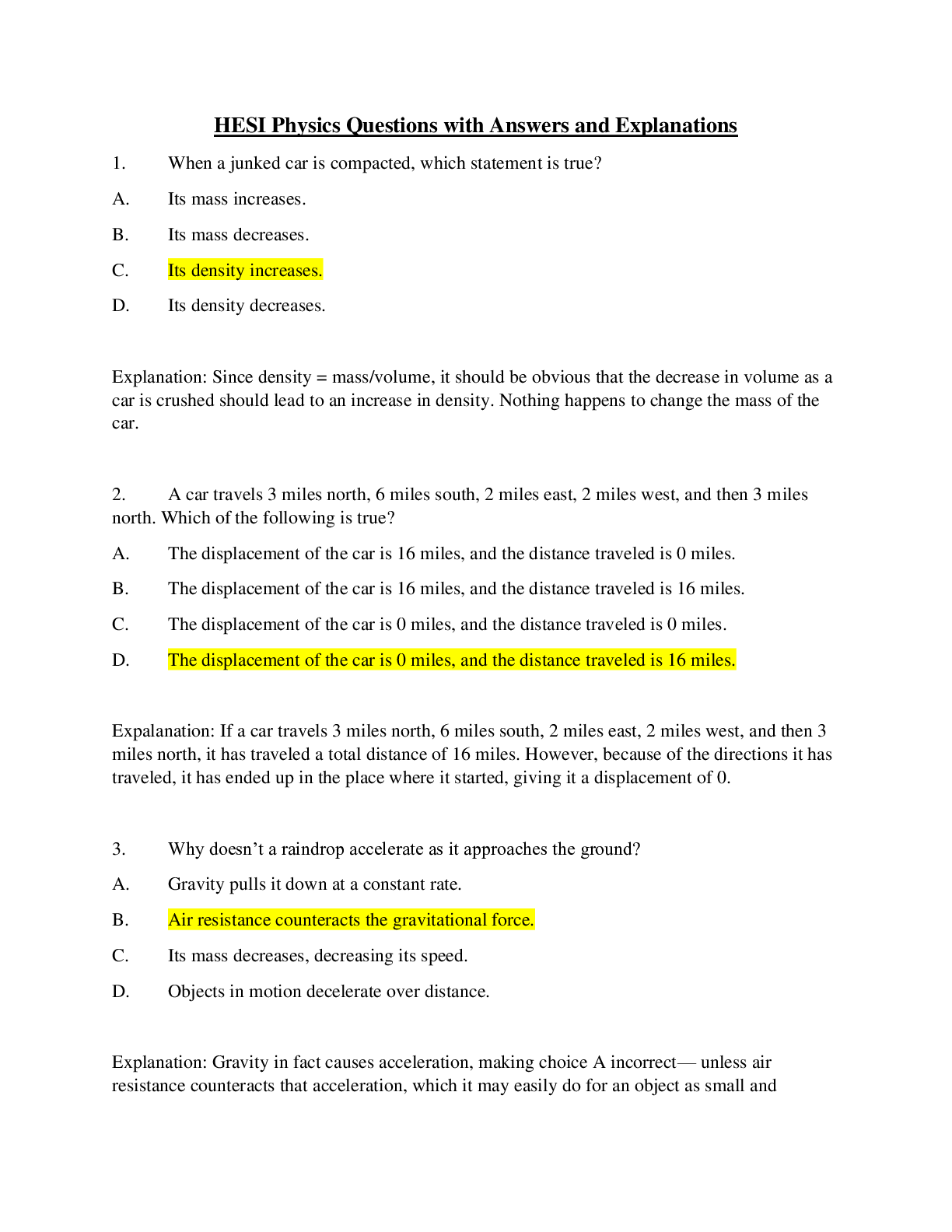

.png)
